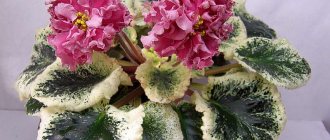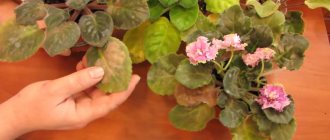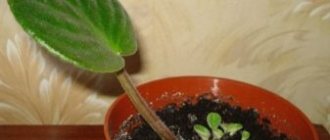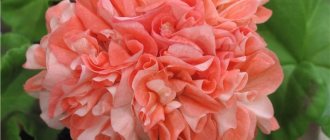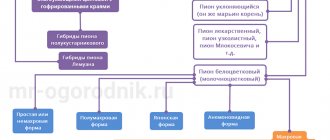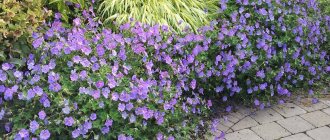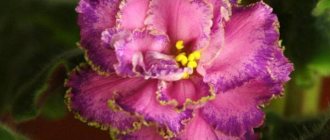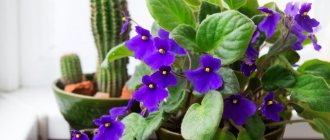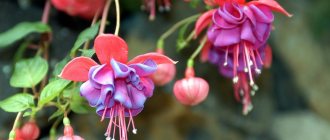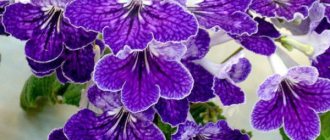It's no secret that until a violet appears in the house, it is impossible to be considered a real florist . Indeed, any representative of the species is striking:
- Or with your tenderness;
- Or velvety;
- Or a riot of bright blooms.
All the violets certainly do not leave anyone indifferent. And about the Maria violet variety, obtained by Tatyana Lvovna Dadoyan by sporting from the Fairy variety, only one thing can be said - she is the unequivocal queen of queens of the violet family. Below we will see in more detail the photo and description of the variety.
Description of the tricolor violet and its flowers (with photo)
Synonyms for tricolor violet: pansy, Ivan da Marya, tricolor, little brothers. The plant is found on forest edges, clearings, meadows among shrubs, on the outskirts of fields in the forest and forest-steppe zones of Eurasia.
Botanical characteristics: annual herbaceous plant 10-40 cm high with a thin taproot, weakly branched. The stem is simple or branched, erect, hollow. Leaves are alternate, glabrous, simple; stem ones are sessile, lower ones are petiolate. Tricolor violet flowers are single, irregular, on long peduncles.
Pay attention to the photo, the flowers of the tricolor violet are dark purple at the top and yellow at the bottom.
The fruits are elongated, ovoid, tricuspid capsules. Blooms in July - August.
Trending Wisteria for the middle zone: dreams come true!
Growing conditions. Unpretentious, but prefers loose, fertile soils.
Usage. Can be used to decorate forest areas and rock gardens. A popular medicinal plant in folk medicine.
Varieties. The species was introduced into cultivation a very long time ago, more than 2000 years ago, and during this time many varieties were created both directly using this species and by crossing it with other species. According to the description, the tricolor violet is most similar to the hybrids of Wittrock violet (V. x wittrockiana).
Currently, it can be difficult to determine which specific species a particular variety belongs to, since it is impossible to trace the origin of many of them, so this species is usually classified as small-flowered varieties that are similar in appearance to wild violet tricolor.
"Hortensis " - numerous, small, purple flowers with an orange eye, spreading bush.
“E.A. Bowles" ("EA Bowles"), or "Bowles Black" ("Bowles Black") - the color of the flowers is black and purple.
The violet tricolor is the official symbol of the city of Athens and Emperor Napoleon.
Graceful violet in the garden
Synonyms. The violet is elegant, the violet is thin.
Distribution area. Balkans, Pyrenees, Asia Minor.
Graceful violet is a perennial plant 10-20 cm high with erect stems. The leaves are coarsely toothed. Flowers up to 4 cm, bluish-lilac or yellow. Blooms from spring to autumn.
In the garden, graceful violet is grown in sun or partial shade, on structured, well-drained, moderately moist, nutritious soils.
Usage. Used to decorate rock gardens.
Varieties of graceful violet and their photos:
"Lord Nelson" - flowers are dark purple, almost black.
"Moonlight" - yellow flowers.
" Major" - flowers are large, purple with a yellow eye.
Perennial horned violet and its photo
Distribution area. Highlands of Southern France, Spain, Italy.
Perennial horned violet has a creeping, highly branched root and numerous erect stems 15-25 cm high.
Forms cushion-shaped, dense bushes. The leaves are ovate-oblong, toothed, up to 6 cm long.
As you can see in the photo, horned violet has elongated flowers, 3-5 cm long.
Shades - from lilac to dark purple, with a small yellow “eye”. Blooms from May to September, but more abundantly in the first half of summer.
A necessary condition for growing horned violet is a dry location. This species reproduces as fragrant violet (V. odorata). Unlike Wittrock's violet (V. x wittrockiana) it does not degenerate for a long time. Prefers a sunny location, moderately fertile soil.
Usage. Horned violet is planted mainly in rock gardens, but in areas with moderately cold winters it can also be planted in flower beds - on flower beds, borders and lawns.
There are many varieties of horned violet. Among them:
" Boughton Blue" - with blue flowers.
"Foxbrook Cream" - with creamy white flowers.
Violet variety " Gazelle".
"Little David" - with yellow flowers.
Violet variety "Gustave Wernig" .
'Helen Mount' has pale blue flowers.
"Milkmaid" - cream flowers with a light blue tint.
"Molly Sanderson" - with purple-black flowers.
"Netty Britton" - with lilac-blue flowers.
"Penny Black" - flowers are almost black.
Talitha has bluish-purple flowers with a white center.
"Victoria Cowthorne" - flowers are lilac-pink.
"White Superior" - large white flowers.
“U.N. Woodgate (WN Woodgate) - flowers are light pinkish-purple-blue.
“Sorbet F1” group consists of 10 varieties with different flower colors.
The flowers of violets growing in nature are most often purple or bluish, less often white or yellow.
A dozen varieties of violets for your window
Pansy, star, bell, bowl, wasp - what do these words have in common? The answer is simple - of course, violet. Her flowers come in this shape. They are also divided according to size, terryness and other external characteristics.
House violet (Saintpaulia ionantha)
photo from almanac.com
If you have not grown violets yet, then you should start with an ordinary indoor Saintpaulia. Outwardly, it is similar to the purple flower that in 1892, during a walk with his bride, was discovered by the military commandant of the Uzambara district of German East Africa, Baron Walter von Saint-Paul. He sent the seeds to his father, who headed the German Dendrological Society. Ulrich von Saint-Paul, in turn, gave them to the botanist Hermann Wendland, who introduced the flower to the world, calling it Saintpaulia in honor of his father and son.
Since then, the Uzambara violet has spread throughout the planet. It is a perennial herbaceous plant with a large rosette and short fleshy stems. Saintpaulia leaves are dark green, heart-shaped, up to 8 cm long, and the flowers are blue-violet.
Apple orchard
photo from extension.unh.edu
Saintpaulias can be of various sizes: from giants (with a rosette diameter of 40-60 cm) to miniature (a rosette up to 6 cm in diameter). Such mini violets include the Yablonevy Sad variety, bred in 2012 by A. Kuznetsov.
Delicate white flowers edged with pink cover a small rosette of dark green leaves. Violet blooms profusely: on each peduncle there are up to a dozen flowers, 2-3 cm in diameter.
Excess fertilizer and sun can lead to flowers turning purple, so shade the plant and do not overdo it with fertilizing.
Vampires Kiss
photo from allaboutafricanviolets.com
A variety for experienced gardeners, because... difficult to grow, and this violet grows very slowly. But the work will pay off handsomely: with each flowering, Saintpaulia becomes more beautiful. It has large dark burgundy semi-double flowers with an almost black border. The leaves are dense, pubescent, dark green in color, and can easily break off.
Flowering lasts a long time, the flowers do not fade for about a month, and lighten over time.
Queen Sabrina
photo from flickr.com
There are violets that combine several varieties. Their subspecies is called the chimera. The petals of such violet flowers have two genetic layers with different colors. Queen Sabrina is also a semi-miniature chimera.
Its large, double, coral-pink flowers have a blue stripe in the center of each petal. The rosette is small (15-17 cm in diameter) with dark green, slightly quilted leaves. Violet always blooms profusely, and with age it becomes even brighter.
It can be negatively affected by the heat, due to which the flowering period is reduced.
Sea Wolf
photo from ebay.com
Giant blue flowers with semi-double corollas, reminiscent of bells, look spectacular against the backdrop of large dark green foliage. This is how the violet variety Sea Wolf, bred by E. Korshunova, appears before us. The flower petals are wavy with a graceful mesh pattern and a white-green edge.
Unlike other violets, it is better to grow a flower of this variety on a well-lit windowsill or loggia.
Blue Dragon
photo from flickr.com
These large double and semi-double light blue violets are recognized not only by the huge size of their corollas, but also by the green border on their wavy petals. Moreover, the border is brighter and wider in cool conditions, but in the heat it is practically absent.
Violets of the Blue Dragon variety are characterized by a powerful rosette (up to 40-50 cm) with dark green leaves, which have jagged edges and a reddish back side. A plant of such impressive size requires increased nutrition and space, so the “dragon” will not tolerate “neighbors” on the windowsill.
Esmeralda
photo from violetbarn.com
The petals of the violet, named after Victor Hugo’s heroine, resemble the wavy hem of a gypsy skirt. This variety is in the collection of two breeders S. Repkina and E. Lebetskaya. The first one has a bright cherry corolla color, the second one is the color of fuchsia or ripe raspberry. The edges of the petals are white.
Large lush flowers look advantageous against the background of evenly colored foliage.
RS Don Juan
The violet bred by S. Repkina bears the name of another literary hero. Large semi-double flowers of purple-plum color are framed by a wide wavy border of golden color. The leaves are large, as is the rosette, which even in young plants reaches 40 cm.
The variety is unpretentious, is not afraid of temperature changes, but loves bright lighting and frequent moderate watering.
EK-White Queen (EK-Belaya Coroleva)
photo from dancinginthegarden.com
Another creation of E. Korshunova, the White Queen violet, also amazes with its huge snow-white corollas. The dark foliage is almost invisible under its double flowers with thin wavy petals.
Grows slowly, prefers cool conditions.
LE-Brilliant Tiffany
Just like the famous diamond, the violet, bred by E. Lebetskaya, shines. Its lush large double white-yellow flowers with wavy green edges glow in the sun like a real jewel. White and pink flowers may bloom on individual peduncles.
The leaves are small, with slightly wavy edges, like the violet itself, and grow slowly. Flowers on it do not wither for a long time and remain fresh.
Garden perennial Labrador violet
Compact, low (5-10 cm) bushes with rounded heart-shaped leaves and delicate, medium-sized flowers rising above the foliage. The color of the leaves is bronze or dark purple, especially bright in spring and early summer. The color of the flowers is pink-carmine. Flowering - late May - June.
Garden perennial Labrador violet grows well in full sun, but can tolerate partial shade. Very cold-resistant. Loves fertile, moderately moist soil.
Propagated only by seeds, which are sown in the ground in the fall or from March to May in boxes for seedlings. Seeds can germinate for quite a long time - within 1-15 months. Under favorable conditions, plants can self-sow.
Usage. In rockeries, in the foreground of mixborders, under sparse bushes, in tree trunks.
Variety "Purpurea" - dark purple flowers.
Manchurian violet in the country
A perennial herbaceous plant from 6 to 20 cm in height, with a short rhizome and ovate-lanceolate leaves on long “winged” petioles.
The flowers are dark purple, 2.5-2.6 cm in diameter, rising above the leaves on long stalks. On one plant, from 8 to 14 flowers open simultaneously.
Blooms in May - June, abundant flowering, lasts for a month.
Growing conditions. Photophilous, cold-resistant. Prefers loose, nutritious, moderately moist soils. Propagated by seeds and division of clumps. Can produce abundant self-seeding.
Usage. It can be grown in rockeries, mixborders, as well as in gardens and parks on the edges along bushes and in open places, where it forms beautiful clumps. Manchurian violets are also widely used in the country, the main thing is to provide it with regular watering.
There are many varieties with different colors and sizes of flowers, as well as with double or variegated (hatched) flowers:
" Myo-Jin" - with purple flowers.
"Fuji Dawn" - with white-variegated leaves.
"Ebiche" - with pink flowers.
Interesting on the topic:
When to remove mulch in spring
Jan 31, 2022
What is forbidden to do with cucumbers if you don’t want to lose...
Jan 31, 2022
Moth violet and its photo
Synonyms. Sister violet, sororia violet (V. sororia).
A perennial plant 15-20 cm high. The leaves are heart-shaped or kidney-shaped, crenate, on long petioles, pubescent.
As can be seen in the photo, violet of this species has relatively large flowers with dark blue, purple, blue, and pink petals.
There are varieties with white petals with purple stripes or specks. The center of the flower is usually greenish-cream or white. The spur is creamy white. Blooms in May.
Growing conditions. A bright or slightly shaded place, nutritious, moderately moist, well-drained, loose soil.
Usage. Rockeries, rock gardens. Can be very weedy.
Varieties of violet moth:
"Gloriole" - white flowers with a blue eye.
"Red Giant " - pinkish, large flowers.
"Speckles " - purple petals with white speckles.
"White Ladies" - the flowers are large, pure white.
"Freckles " - white flowers with purple speckles.
"Alice Witter" - the flowers are pure white with a pink center and veins.
Skornyakova varieties
- Foreign selection
- Alen-... - CT-...
- LE-... (Lebetskaya variety)
- LEKO-... - NK-...
- PT-… (Pugacheva variety)
- RM-… (Skornyakova variety)
- RS-… (Repkina varieties)
- Fairy – YAN-Dressy
- Miniatures and semi-miniatures
- Streptocarpus
For fans of domestic selection, the catalog includes beautiful and very interesting varieties from the most popular breeders of Russia and Ukraine.
The price is indicated in rubles per plant leaf. The letter “L” indicates varieties that will be sold in the summer after mandatory prior approval (they will be grown only by summer).
| 605 | RM-Goddess of the Sun (Skornyakova) | Beautiful semi-double flowers with a yellow center that turns into a pink ruffled edge with a green fringe. Light green leaves. |
| 617 | RM-Magic Tulip (Skornyakova) | This is an absolutely unique variety! Flowers of a beautiful pink color in the shape of a not fully open tulip, white eye and border (pink prints on white) and with a light raspberry coating. Light green, slightly quilted, pointed leaves. |
| 620 | RM-Blue Firmament (Skornyakova) | Huge, up to 9 cm, semi-double wavy blue flowers. Smooth rosette, medium green leaves. Abundant flowering. The variety is impressive in the size of its flowers. |
| 626 | RM-Zvezda Regul (Skornyakova)New | Quite large semi-double and double ruffled white stars with a wide cherry border and green fringe. |
| 628 | RM-Games of Poseidon (Skornyakov) | |
| 635 | RM-Light Breeze (Skornyakova) | Large sky-blue single and semi-double ruffled flowers with a white border and light green edge, which is especially good in normal and cool growing conditions, under which darkening also appears along the edges of the petals and the flowering is incredibly beautiful! Standard even rosette of green leaves. Short peduncles, abundant flowering. |
| 640 | RM-Loriana (Skornyakova) | Large simple, semi-double and double white flowers with blue tints throughout the flower, sometimes turning into a mesh. A white and green corrugated border decorates the flowers, making them airy. The flowering is very beautiful, lush, abundant, long lasting, the peduncles are strong and form a luxurious “cap”. The rosette is standard, slightly wavy large green leaves. |
| 645 | RM-Natalia (Skornyakova) | Large single and semi-double wavy white stars with vibrant coral red prints and fantasy blue. Abundant flowering, most effective at higher growing temperatures. Medium green leaves. Standard socket. |
| 650 | RM-Paolina (Skornyakova) | |
| 651 | RM-Girlfriend (Skornyakova) | Large semi-double and double white stars with very bright raspberry-pink prints of a warm shade. Abundant flowering "cap". Neat outlet. Green foliage. |
| 656 | RM-Rosa in Izumrud (Skornyakova) | |
| 657 | RM-Placer of Gems (Skornyakova) | |
| 659 | RM-Russian Bogatyr (Skornyakova) | |
| 660 | RM-Sandra (Skornyakova) | Large semi-double and double fringed coral flowers with a cherry-powdered border. Standard rosette, green leaves. |
| 664 | RM-Treasures of Kings (Skornyakova) | Large, double, fringed, very bright pink flowers with fantasy blue and a raspberry-tinged border. In hot conditions, at temperatures above 30 degrees, there is practically no border on the flowers. Neat outlet. Green serrated leaves. Abundant flowering. |
| 665 | RM-Solar Angel (Skornyakova) | |
| 666 | RM-Sun on the Snow (Skornyakova) | |
| 667 | RM-Sun of July (Skornyakova) | Small semi-double and double touchingly delicate pink flowers with a yellow center. The edges of the petals are wavy in a beautiful soft pink color, the yellow center is well defined. Powerful flower stalks. Abundant flowering in clusters. Standard rosette, green leaves. |
| 672 | RM-Francesca (Skornyakova) | The flowers are large, non-falling, white with luxurious blue ruffles along the edges of the petals. Flowering is abundant. |
| 673 | RM-Fruit Zephyr (Skornyakova) | The flowers are beautifully shaped, lush, ruffled, white with deepening pink towards the edges of the petals, a pink center and a light blue fantasy. Abundant flowering, good peduncles. Light green leaves. |
| 674 | RM-Almond Flowers (Skornyakova) | |
| 680 | RM-Berry Marmalade (Skornyakova) | Large, densely double, fringed white flowers with a vibrant coral red center and fantasy blue. Green leaves. Abundant flowering. |
- Foreign selection
- Alen-... - CT-...
- LE-... (Lebetskaya variety)
- LEKO-... - NK-...
- PT-… (Pugacheva variety)
- RM-… (Skornyakova variety)
- RS-… (Repkina varieties)
- Fairy – YAN-Dressy
- Miniatures and semi-miniatures
- Streptocarpus
Variegated violet in the garden
Forms a rosette of leaves up to 15 cm high, without shoots. The leaves are dense, kidney-shaped, 2.5-5 cm long, pubescent, dark green on top with silver veins, purple underneath.
Growing conditions. In nature it grows on dry slopes, steep cliffs, and dry steppes. In the garden, variegated violet requires bright, dry places with good drainage from fine crushed stone.
Use: Rockeries, alpine slides.
Varieties of variegated violets in the photo with descriptions:
"Syletta" - often sold under the name "cyclamenolifolia violet", has bright veins on the leaf blades.
Violet variety "Sylvia Hart" - with bright silvery veins on the leaves.
Red violets: top 10 most popular varieties
LE Whipped cream
This unique variety, signed by Elena Lebetskaya, is the dream of many collectors.
The leaves are collected in a neat rosette with light leaves that curl slightly at the edges. The reverse side of the sheet has a red tint. The diameter of the rosette reaches 17 centimeters.
Whipped cream flowers are very large, double, and resemble whipped cream. There is a flounce along the edge of each petal that adds airiness. There is no uniform color; crimson streaks appear randomly and depend on the time of year, temperature and lighting.
The flower size reaches 6 centimeters.
Note! The author described its variety as follows: “The flowers are large, white, with a thin wavy crimson border running along the edge of the petal.” All other options are sporty.
LE Summer red
Saintpaulia from Elena Lebetskova is distinguished by a large, uniform rosette and long, bright green leaves.
The flowers are large, dark red or burgundy in color, reaching 7 centimeters in diameter. There is a wavy white border along the edge of the petals.
Blooms profusely and forms a beautiful bouquet. The color of the petals may change depending on the lighting or air temperature.
EK Bullfight
This is a variety from the author Elena Korshunova. A distinctive feature of bullfighting is its very large flowers, reaching 8 centimeters. The rosette of large leaves is dense and grows up to 30 centimeters in adulthood.
Color varies from ruby to bright scarlet. Saturation depends on the conditions of detention.
This variety does not form rosettes, but this does not affect its attractiveness, since all the flowers are large and the flowering period is long.
The plant needs regular feeding, good lighting and regular removal of the lower leaves.
Gold
Very often, subsequent generations of the Fight by Bulls variety do not possess the main varietal characteristics. But sometimes worthy examples appear, for example, Fight of the Bulls Gold.
This variant has a variegated rosette with a light dot in the center.
LE Ruby Mongols
The author of the Saintpaulia hybrid is Elena Lebetskaya.
The color of the petals has a ruby tint, which was the reason for the name. The flowers are large, slightly velvety to the touch, and have a small wavy border at the edges. When given enough light, these flowers shine and have a dark spot in the center.
This variety does not form caps; it usually blooms from 3 to 5 flowers, but this is compensated by a long flowering period (up to 6 months). After a short rest, Saintpaulia resumes flowering.
Rubin Monogolov prefers bright lighting. But if a specimen of this variety has been in partial shade for a long time, then this plant cannot be exposed to harsh sun - there will be burns on the leaves. This needs to be done gradually.
Ruby Mongols violet leaves are dark green and glossy, forming a beautiful rosette.
Frosty cherry (Morev)
This variety from Konstantin Morev has large double flowers up to 4 centimeters in diameter. The color is white, with a large cherry spot in the center.
Sometimes Frosty Cherry changes color intensity, the flowers can be completely white with a small pink spot, and sometimes deep crimson.
The leaves are round and form a beautiful rosette. The plant does not like drafts. The color does not depend on the conditions of detention.
The value of the variety lies in its long flowering period (10 months) and good response to fertilizing.
Carefully! In very hot conditions, many Saintpaulias are whiter in color, and in winter the petals develop a dark red or burgundy color.
LE Polina Viardot
Variety of Elena Lebetskaya. The rosette is large, the leaves are variegated, they prefer not to lie horizontally, but to bend slightly.
The flowers are single and double, with a wavy white border along the edge. Pauline Viardot does not form a large bouquet, but this is compensated by large flowers on a variegated rosette.
This variety grows very slowly and does not begin to bloom until it has become a large rosette.
For propagation, leaves with a lot of greenery are chosen, and the babies are planted as late as possible so that green spots form on them. Old and young leaves are not suitable for propagation.
Hummingbird (K. Morev)
Variety of Konstantin Morev. The flower shape is pansy. Color: red with a wavy light green edge.
The rosette is very compact, small, this variety can be grown as a semi-standard variety.
Carefully! Hummingbirds react very poorly to bright light. The leaves take on an unsightly yellow or brown tint and begin to bend. Short stems can be deformed. Flowering time is significantly reduced. The recovery period is very long. This variety needs to be shaded immediately.
AV Tango (Violetgrower)
The uniqueness of the variety lies in the unusual bright color of the beets. Breeder - Vyalkovod.
The flowers are large, double, and velvety to the touch. Large flower stalks hold weight well and do not fall off.
The peculiarity of the variety is that when cuttings are taken, the peduncle first grows, and then the leaves appear.
Bright green leaves form a single rosette.
EK Agate tulip
The variety of breeder Elena Korshunova got its name from the shape of the flower, reminiscent of an open tulip.
The color of the flowers is salmon, the shape can be simple and terry, and does not depend on the conditions of detention. The size of the flowers reaches 6 centimeters. The peduncles are small and strong, do not fall out and hold on well.
The leaves are dark green with a red tint inside. Forms a uniform, beautiful large rosette.
EC Gardens of Babylon
Varieties author Elena Korshunova. It has large double flowers of red color with a rich coral tint. The stems of the flowers are elongated, the flowers droop slightly, which makes them look like pompoms.
Flowering cascading. Over time, the color becomes darker. Babylon purple gardens look beautiful in hanging pots. The leaves are small, but the long cuttings form a wide rosette.
This variety needs a lot of space. The plant must be regularly rejuvenated and side shoots removed.
Sport Shanghai Rose, which you see in the photo below, has folded peduncles, a white border along the edge of the petal, and is unstable.
Korean garden violet (with photo)
Synonyms. Griffon-horned violet (V. grypoceras).
Korean violet is a perennial plant that forms a rosette of heart-shaped basal leaves at the beginning of the growing season, and then lodging leafy shoots with delta-shaped leaves.
Growing conditions. Loves moderately shady places, moist, nutritious soils.
Usage. In shady gardens, under the canopy of trees and shrubs.
Garden violet variety "Mars" - forms a large leaf rosette up to 20 cm high. As can be seen in the photo, this garden violet has variegated leaves with dark purple rays diverging from the midrib. The flowers are lilac-colored, fragrant, and are found mainly under the foliage.
Growing fragrant violets and photos of flowers
Synonyms. The violet is fragrant.
The distribution area of fragrant violet is the broad-leaved forests of Western Europe, Crimea, the Caucasus, the Balkans, Asia Minor and Western Asia, and northern Africa. Everywhere in culture.
Perennial up to 15 cm high, with a short and thick underground stem and shoots that bloom in the second year.
According to its description, fragrant violet is similar to other species, but has a pronounced pleasant aroma, for which it received its name.
Pay attention to the photo, fragrant violet has leaves with long petioles, round or ovoid, with a finely toothed edge, up to 6 cm long.
Fragrant violet flowers are about 2 cm in diameter, on long thin stalks, blue, violet, purple, white, single or double. Flowering is abundant, twice a year - at the end of May and at the end of summer.
When growing fragrant violets, it is necessary to ensure moderate moisture and soil fertility. Grows well in sun and partial shade. Propagated by seeds, dividing the bush and cuttings. Young plants begin to bloom in the second year of life. In harsh winters with little snow, plants can be damaged and bloom poorly the following season. Does not tolerate drought well. Can produce abundant self-seeding.
Usage. This species can be used to decorate light and semi-shaded areas, edges near trees and shrubs, where plants form wide clumps with continuous cover.
Varieties of fragrant violets are presented below:
"Bechtles Ideal" is a large-flowered, forcing variety.
"Queen Charlotte" - flowers are lilac-blue, large, the variety is suitable for forcing.
"Coeur d'Alsace" ("Soite d"Alsace") - pink flowers.
Variety of fragrant violets "Chris"
"Alba" - white flowers.
Variety " Red Charme"
"Rubra" - red-purple flowers.
"Triumph" is a violet variety with very large flowers.
“The Tsar” (“The Czar”) - lilac flowers, very fragrant.
Varieties:
Fragrant Parma violet, or Parma violet (V. odorata var. parmensis). Cultivated in some areas of France, mainly in the south, around Nice, and also in Northern Italy, near Parma.
It differs from the main species in its large, double, very fragrant flowers. Widely used in the perfume industry, in particular to create extracts for perfumes.
EK-Volcano Magic
The variegated variety represents the achievements of the breeder from Togliatti, Elena Vasilievna Korshunova. This is a completely new product, released for sale in 2022.
Species affiliation
In terms of the size of the leaf rosette, the variety is included in the standard type , in terms of the color of the leaf blades it is a typical variegated type, in terms of the color of the corolla it is a monochromatic type, and in terms of the flower shape it is a simple rounded star.
Description
Violet EK-Magic of the Volcano forms a fairly neat rosette , although not too dense in fullness. Rounded-elongated leaves are arranged on long petioles in a mosaic pattern throughout the rosette space.
A distinctive feature is the variegated leaves of the bordering type : the dark green of the glossy leaf plates along the contour is surrounded by a pink patterned ribbon with crimson reflections. In some copies, the pink insert fills more than half of the sheet.
Above the rosette are large (up to 7 cm) corollas of simple shape, colored with tints of crimson with a transition to cherry shades. The edges of the petals are decorated with strong wavy , and their special charm is achieved by their velvet structure.
Features of growth and flowering
Developmental features include:
- formation of a sparse rosette;
- the arrangement of buds is quite rare for the cap type;
- Intensification of the variegated leaf pattern with decreasing temperatures and as the number of flowerings increases.
Nuances of maintenance and care
For variegated varieties, maintaining the temperature regime is very important - when kept cool (within +18 + 20°C), the variegation becomes brighter and more voluminous.
CAREFULLY! Abundant fertilizing with fertilizers with a high percentage of nitrogen will harm the decorative appearance of the leaf rosette, as the process of chlorophyll formation will intensify, which will lead to the disappearance of the white pattern.
To propagate by leaf, it is better to take a leaf plate without variegation , and before separating the children from the mother plant, you should wait until they acquire a green color - leaves and layering without chlorophyll are not able to feed on their own and may die.
Reviews
Violetta Karlovna. “The violet variety is not very full in terms of the fullness of the rosette, but is incredibly good due to the color of the leaf blades. It is quite rare to find a combination of dark green leaves with pinkish-cherry patterns and specks along the edges. An indescribable feeling."
Matvey Egorovich. “I have been collecting Saintpaulias for many years. I purchased “Volcano Magic” at an exhibition – I was captivated by the colors of the leaf rosette. The name is given very accurately, the drawing in tone and outline really resembles lava flowing from a volcano. And it’s truly fascinating.”
Garden violet ivy
Synonyms. Violet ivy; reniform violet (V. reniforme).
A perennial plant 2.55 cm high with long, thin, creeping, intertwining shoots, with numerous small rounded leaves creating a continuous wide carpet.
Above the leaves, small round flowers open on long stalks, the central part of which is painted purple, and the tips of the petals are white.
Growing conditions. The plant is thermophilic, does not tolerate frost and does not overwinter in temperate climates. Loves damp, marshy places. In the summer, the plants are taken out into the garden and placed in a cool, bright room for the winter, reducing or temporarily stopping watering and fertilizing. Propagated by dividing clumps in the spring.
Garden ivy violet is cultivated as a container ground cover or carpet plant, most often together with other tall ornamental crops. Prefers partial shade.
Variety "Blue Form" - lilac-blue flowers.
Basic rules of care in indoor culture
For Saintpaulia "ND Smuglyanka" it is enough to comply with standard maintenance regimes.
Growing conditions in collections
Ideally located on eastern and western windows , the northern direction requires lighting, the southern direction requires violet shading.
Features of watering and fertilizing
Watering frequency – twice a week after drying the soil; feeding - once a month as needed.
Light level
The violet requires long-term illumination with a diffuse spectrum without contact with the direct rays of the luminary.
Optimal temperature conditions
Saintpaulia is most suitable for a microclimate with temperatures of +20 + 24°C.
A note on the temperature regime of violets.
Indoor air humidity
Humidifiers or regular spraying near the violet will help increase humidity
Substrate requirements
A nutritious, aerated, water-permeable substrate with a light structure is required Be sure to have drainage in the flowerpot.
Hygienic cleaning
should be carried out .
Nuances of the transplant procedure
Young violets can be replanted once a year, adult specimens - as they grow out of the flowerpot. The choice between transplantation or transshipment depends on the goals of the procedure.
Growing violet capillary
Synonyms. Oblique violet (V. obliqua).
A perennial plant 15 cm high. The leaves are heart-shaped or kidney-shaped, crenate, on long petioles, pubescent. The flowers are relatively large, the petals are dark blue, purple, and white. Blooms in May.
The best conditions for growing violet cape are a bright or slightly shaded place, nutritious, moderately moist, well-drained, loose soil.
Usage. Rockeries, rock gardens. Can be very weedy.
The most common varieties of garden violet are shown below:
"Alba" - white flowers.
"Bicolor" - white flowers with purple veins.
"Gloria" is a hybrid with glossy leaves and white flowers with blue strokes.
"Rubra" - purple flowers.
Violet Maria (T. Dadoyan)
Tender violet Maria (T. Dadoyan).
The species that loves mountainous Africa, “violet” (or Saintpaulia), contains both annual and perennial plants . It belongs to the Gesneriaceae family. The flower has enjoyed enormous unabating popularity all over the world for many decades. The species is valuable not only for the diverse beauty of its varieties, but also for its rather unpretentious maintenance requirements.
The main thing is to know the basics of care , and sincerely admire your specimen - this way the plant will try its best to please the owner with exuberant flowering.
History of origin
Experienced and widely known breeder Tatyana Lvovna Dadoyan obtained Maria by sporting from the Fairy variety . The fairy, a double miracle, covered with large white flowers with a deep pink tint, became a good parent, passing on to Mary all her varietal beauty. This is how a luxurious fixed sport turned out.
The variety belongs to Tatyana Dadoyan.
Quote (T.L. Dadoyan): “The flowers are large, up to 7 cm. Densely double, they remain in the form of “heads of cabbage” for a long time during dissolution. The petals are white with a slight pinkish tint, along the edge there is a crimson border with a dusting and a thick green ruffle. The leaf is medium green, wavy.”
Maria has the same one as the Fairy:
- Fluffy corrugated edge frill of petals;
- And the delightful shape of the flowers, reminiscent of a delicate rose enclosed in a head of cabbage.
Distinctive features
- Densely double large flowers (5 – 7 cm);
- The petals are white with a pinkish tint, the border is from fuchse to bright crimson, ending in a light green thick ruffle;
- The brightness of the color is determined by temperature and lighting;
- Flowering is exceptionally long;
- The leaves are standard, lush green, with a light wavy edge and curly at the rosette;
- Loose, voluminous rosette;
- The petioles are long.
The plant develops slowly; before flowering it needs to become sufficiently strong , but this feature is more than compensated for by its unpretentiousness and abundance of children.
Advice! A real varietal plant will “overgrow” with a light green ruffle in any case, but to be sure, you should wait for at least the third flowering.
